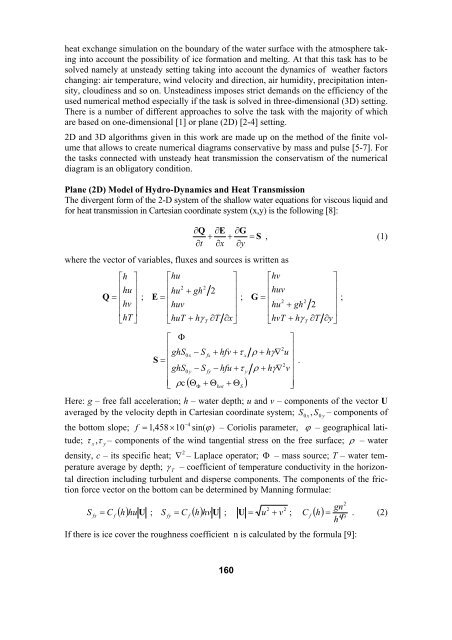Create successful ePaper yourself
Turn your PDF publications into a flip-book with our unique Google optimized e-Paper software.
heat exchange simulation on the boundary of the water surface with the atmosphere taking<br />
into account the possibility of ice formation and melting. At that this task has to be<br />
solved namely at unsteady setting taking into account the dynamics of weather factors<br />
changing: air temperature, wind velocity and direction, air humidity, precipitation intensity,<br />
cloudiness and so on. Unsteadiness imposes strict demands on the efficiency of the<br />
used numerical method especially if the task is solved in three-dimensional (3D) setting.<br />
There is a number of different approaches to solve the task with the majority of which<br />
are based on one-dimensional [1] or plane (2D) [2-4] setting.<br />
2D and 3D algorithms given in this work are made up on the method of the finite volume<br />
that allows to create numerical diagrams conservative by mass and pulse [5-7]. For<br />
the tasks connected with unsteady heat transmission the conservatism of the numerical<br />
diagram is an obligatory condition.<br />
Plane (2D) Model of Hydro-Dynamics and Heat Transmission<br />
The divergent form of the 2-D system of the shallow water equations for viscous liquid and<br />
for heat transmission in Cartesian coordinate system (x,y) is the following [8]:<br />
where the vector of variables, fluxes and sources is written as<br />
∂Q<br />
∂E<br />
∂G<br />
+ + = S , (1)<br />
∂t<br />
∂x<br />
∂y<br />
⎡h<br />
⎤ ⎡hu<br />
⎤ ⎡hv<br />
⎢ ⎢ 2 2 ⎥ ⎢<br />
hu<br />
⎥<br />
⎢ ⎥<br />
2<br />
; ⎢<br />
hu + gh<br />
huv<br />
Q = E =<br />
⎥ ; G = ⎢<br />
2 2<br />
⎢hv<br />
⎥ ⎢huv<br />
⎥ ⎢hu<br />
+ gh 2<br />
⎢ ⎥ ⎢<br />
⎥ ⎢<br />
⎣hT<br />
⎦ ⎣huT<br />
+ hγ T<br />
∂T<br />
∂x⎦<br />
⎣hvT<br />
+ hγ T<br />
∂T<br />
⎡ Φ<br />
⎤<br />
⎢<br />
2<br />
⎢<br />
ghS0x<br />
− S<br />
fx<br />
+ hfv + τ<br />
x<br />
ρ + hγ∇<br />
u<br />
S =<br />
.<br />
⎢<br />
2<br />
ghS0<br />
y<br />
− S<br />
fy<br />
− hfu + τ<br />
y<br />
ρ + hγ∇<br />
v<br />
⎢<br />
⎢⎣<br />
ρc<br />
( ) ⎥ ⎥⎥⎥⎥ ΘΦ<br />
+ Θbot<br />
+ ΘS<br />
⎦<br />
⎤<br />
⎥<br />
⎥<br />
⎥<br />
⎥<br />
∂y⎦<br />
Here: g – free fall acceleration; h – water depth; u and v – components of the vector U<br />
averaged by the velocity depth in Cartesian coordinate system; S – components of<br />
S0 x,<br />
0 y<br />
−4<br />
the bottom slope; f = 1,458 × 10 sin( ϕ)<br />
– Coriolis parameter, ϕ – geographical latitude;<br />
τ<br />
x<br />
, τ<br />
y<br />
– components of the wind tangential stress on the free surface; ρ – water<br />
2<br />
density, c – its specific heat; ∇ – Laplace operator; Φ – mass source; T – water temperature<br />
average by depth; γ<br />
T<br />
– coefficient of temperature conductivity in the horizontal<br />
direction including turbulent and disperse components. The components of the friction<br />
force vector on the bottom can be determined by Manning formulae:<br />
S<br />
2<br />
2 2<br />
gn<br />
= C<br />
f<br />
( h) hu U ; S<br />
fy<br />
= C<br />
f<br />
( h) hv U ; U = u + v ; C<br />
f<br />
( h) . (2)<br />
4 3<br />
h<br />
fx<br />
=<br />
If there is ice cover the roughness coefficient n is calculated by the formula [9]:<br />
;<br />
160

















